When it comes to infestations, bed bugs are among the worst.
Not only can they be hard to get rid of, but their bites can be painful, itchy, and leave you wondering how you got into this mess
In order to quickly remove bed bugs…
It is critical to identify them first.
They like to hide around things like:
- Furniture
- Walls & baseboards
- Within mattresses
Therefore, the only sign of their existence could be the bites they leave behind.
It is critical to be able to tell bed bug bites apart from other insect bites.
Some of the key features of bed bug bites are:
- They tend to leave their bites in lines or clusters.
- There are red, itchy welts that are most irritating in the mornings.
- There could be hives if the victim has allergies.
- Exposed areas of skin are most vulnerable.
With some of the most common signs of bed bug bites in mind…
It’s time to look at key differences between those and other insects.
On that note… Let’s dive in.
Page Contents:
Bed Bug Bites vs. Spider Bites
Many people confuse bed bug bites with spider bites…
But the key here is looking at whether there are distinct puncture marks.
Spider bites tend to contain a more “puncture” look, as if someone perforated the skin with a small nail.
Apart from this, spider bites can present wildly different results depending on the spider that caused the bite.
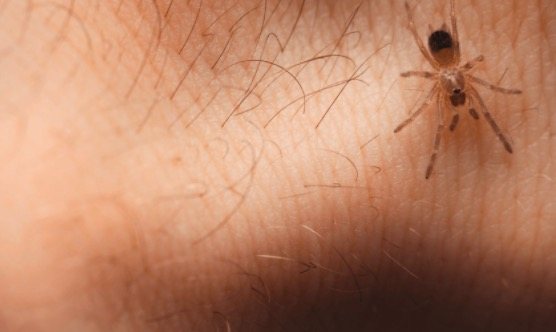
However, the vast majority of spiders pose no danger to humans. Of the 3,500 species that inhabit the United States, only 2 spider species can be deadly: the black widow and the brown recluse.
The majority of the 3,000 spiders in the U.S. aren’t dangerous.
Identifying a spider bite is easier if you know which species bit you, but the spider is usually long gone by the time you discover the bite. Thus, you should look for distinct symptoms like:
- Pain around the bite area.
- Muscle pain or cramping.
- Sweating or difficulty breathing.
- Nausea and vomiting.
Spider bites can also take longer to heal than other insect bites, and they can affect deeper skin tissues that result in long term health effects.
In the case of black widow and brown recluse spiders, severe symptoms can include:
- Pain & swelling around the bite
- Nausea & a fever
- Cramps
- Skin ulcers
Bed Bug Bites vs. Hives

If you suffered an allergic reaction at any point in your life, then you know what hives look like.
Anything can trigger hives because allergies can be present in almost any form.
Furthermore, if you have an allergy to bed bugs…
Then you might develop hives as a result. This would be a double whammy of a situation.
Like bed bugs, hives turn into angry, red welts.. They are painful and tend to resemble wheels.
While bed bug bites may not show up for days, hives will appear instantly after the incident occurs.
Characteristics of hives include:
- Splotchy
- Sporadic
- Usually in a widespread pattern
- Can appear anywhere on the body

In general, bed bug bites are far fewer in number than hives.
Also, it is possible to treat hives with antihistamines, after of which hives will disappear relatively quickly.
While antihistamines can stop bed bug bites from itching, and heal other bite symptoms…
This will not make them go away and faster.
The MAIN thing that heals bed bug bites is time.
Bed Bug Bites vs. Mosquito Bites
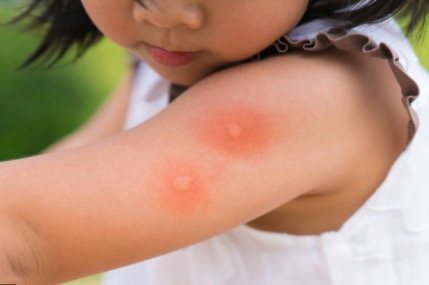
One of the most common misconceptions involves the similarities between bed bugs and mosquitos.
While some people might think that bed bug bites look like mosquito bites…
There are a few differences to note:
- Mosquitoes tend to leave only 1 or 2 distinctive marks on the skin. In contrast, bed bug bites tend to show up in multiples.
- People tend to feel it when a mosquito bites them. In contrast, bed bug bites are usually not felt at all. The saliva in the mouths of bed bugs will numb the surface of the skin, leading their bites to go unnoticed.
It is rare for people to have only 1 bed bug bite. So if that’s the case, it’s more likely a mosquito than a bed bug.
A mosquito needs to be on your skin for at least 6 seconds to finish biting you. These bites will also only last for 2 to 3 days before they begin to subside.
Bed bugs on the other hand…
Will bite you for around 10 minutes.
At that point, they are fully engorged and will slowly walk away from their host.
Bed Bug Bites vs. Flea Bites
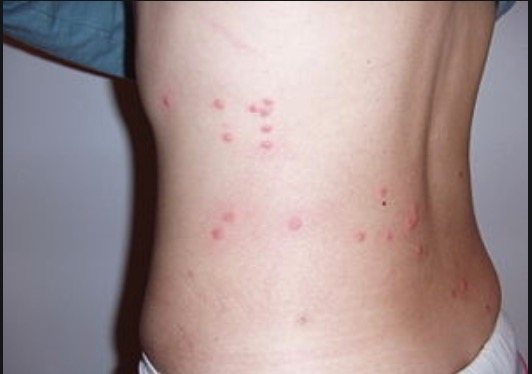
Flea bites and bed bug bites are the easiest to confuse. The good news is that there is still a simple way to tell them apart…
Let’s look at 2 key differences:
- The location of the bite on your body.
- The number of bites that occurred in the affected area.
Flea bites are usually more sporadic. They tend to be spread out and show up around the feet and ankles commonly.
In contrast, bed bug bites are more common to be on exposed portions of the skin along the upper torso, such as the arms and neck.
While bed bug bites can impact the feet and ankles, this is more unusual.
Finally, remember that bed bug bites tend to show up in
Lines, clusters, or zigzag patterns.
Flea bites usually don’t have a distinctive pattern.
Bed Bug Bites vs. Chiggers
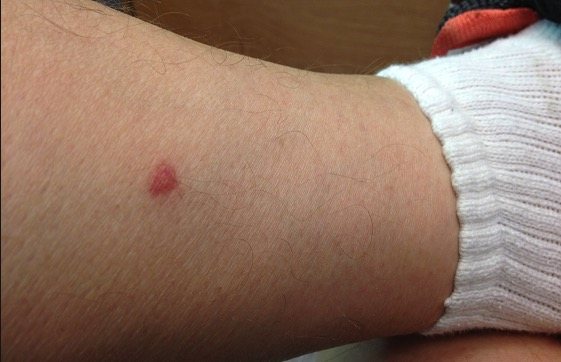
While it is possible for you to have chiggers in your bed biting you, this is highly unusual.
Chiggers tend to like areas that are
- Moist
- Wet
- Usually within dense woods
For this reason, they will rarely show up in your bedroom.
Though if you spend a lot of time outside and you aren’t sure where those weird marks came from, you might have chiggers.
So what should you look for in chigger bites?
Look at the location of the bite on your skin. Chiggers almost always bite people around the waist. These bites will also leave welts behind.
While it is possible for you to have bed bug bites around your waist, if you sleep clothed, your waist is then unexposed and can not easily be accessed.
Therefore, bed bugs will not target this area. The marks will probably be higher up, on places like your
- Abdomen
- Chest
- Neck
- Arms
In general, bed bug bites are also smaller than chigger bites.
Bed Bug Bites vs. Scabies
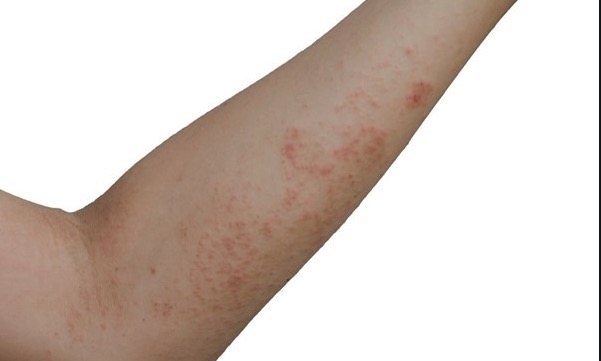
Scabies is an itching condition that is caused by a burrowing mite called Sarcoptes Scabiei.
This condition is highly contagious and will spread quickly through close physical contact.
Another common question involves bed bug bites and scabies. While both can lead to serious itching, scabies do not leave small bumps behind.
Scabies bites tend to look more like a rash.
They leave raised lines behind because they like to tunnel under the skin to lay their eggs.
These burrows or tracks will usually appear in the folds of the skin, though any part of the body can be involved.
Scabies is typically found in these areas:
- Between fingers.
- In the armpits.
- Along the wrists.
- On the soles of the feet.
- On the knees.
- Around the waist.
This is where the itching comes from.
Scabies bites will begin to emerge anywhere between 4 and 8 weeks after infestation. They may clear up after 1 to 2 weeks, but over-the-counter products called “scabicides” can help eradicate the mites for good.
Bed Bug Bites vs. Tick Bites
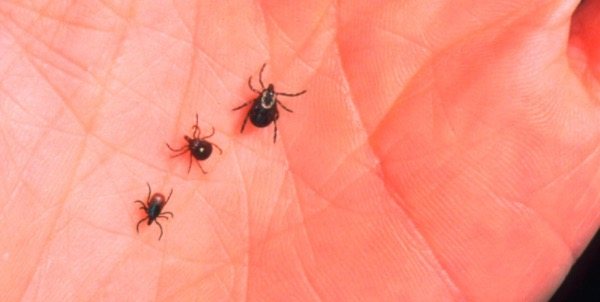
Ticks are special in that they’re attracted to both people AND their four-legged pets.
Similar to bed bugs, tick bites don’t usually cause serious harm.
Tick bites will either result in mild symptoms or even no symptoms at all.
There are cases however when ticks can cause allergic reactions, and their bites will pass sickness (most commonly Lyme disease) onto their host.
Ticks prefer, warm, most areas of the body that include:
- Armpits
- Groin
- Hair
And unlike bed bugs, they will remain attached to your body after they bite you.
The time of day these insects bite differs as well.
Bed bugs usually bite at night or just before the dawn, when their hosts are asleep.
Ticks can bite during the day, and will usually attach themselves to a host that’s walking through the woods or thick brush.

Ticks use a technique called “questing,” where they attach themselves to leaves or grass with their hind legs. Then, with their forelimbs extended outward, they will latch onto any host that comes their way.
A bed bug can also bite multiple times, whereas a Tick will bite you just once.
(And continue to draw blood from that singular bite spot).
Bed Bug Bites vs. Roach Bites
Not many people know that cockroaches even bite… but this large creepy pest can also bite you.
Similar to bed bugs…
You will see cockroaches running around during the night as they are nocturnal.
Roaches will also bite specific areas of the body that include:
- Mouth
- Fingers
- Hands
- Face
The reason for this is because food residue accumulates in these areas.
In terms of appearance:
Cockroach bites are more powerful, about 1-4 mm in diameter, slightly larger than bed bug bites.
They often appear as singular inflamed areas of skin.
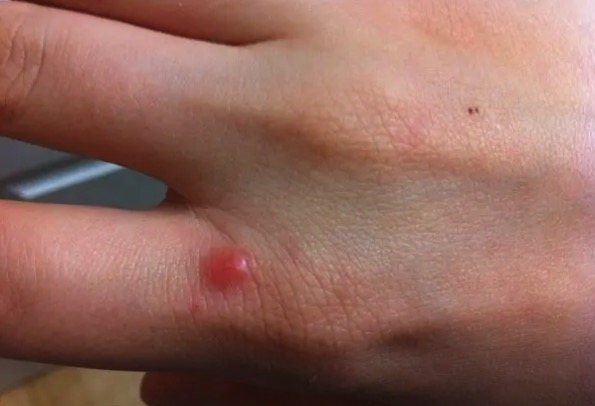
Their bite force is actually 50 times stronger than their body weight.
Bite marks left by roaches are bright red, swollen, and very itchy. Repeated itching can lead to infection, and cause the bite to swell to the size of a golf ball.
It’s important to note that cockroach bites are rare.
Whereas you are almost guaranteed to get bitten during a bed bug infestation, roaches might be present but aren’t necessarily looking to bite you.
Bed Bug Bites vs. Poison Ivy

Among people who experience large rashes or red patches on their body are almost always wondering whether this is from a bed bug rash, or a poison ivy rash.
There are many common factors to both poison ivy and bed bugs, so you may need to get your skin looked at by a professional.
Here are a few key differences:
Appearance: Bed bug bites will have distinct raised areas on the skin. Often in the form of clusters or a random pattern. A poison ivy rash will not have bumps or any raised areas.
Placement: While bites are typically found on exposed areas of the skin, a rash from poison ivy starts small, but can spread to areas that were previously unexposed. You may also experience blister-like eruptions, which release a water liquid similar to burn blisters.
Symptoms: Bed bugs will cause fairly intense itchiness, whereas poison ivy will vary more person by person. It will completely depend on the individual’s sensitivity to allergens, and the degree to which they were exposed.

Length of Time: Bed bug bites can last anywhere from a few days to a few weeks.
Poison Ivy typically lasts from 1 to 3 weeks.
Where Do Bed Bugs Bite You?
Unfortunately, bed bug bites can show up anywhere; however, these pests tend to target areas of skin that are exposed at night.
Some of the most common areas include the face, neck, arms, and hands; however, depending on your sleeping position, they might target others as well.
For example:
If you get hot at night and want to stick out your feet, then you might end up with bed bug bites on the lower parts of your body that became exposed.
Do Bed Bug Bites Spread When Scratched?
It is possible for bed bug bites to spread when scratched; however, the spreading is not because the bite itself is spreading.

The rash from bed bug bites might get worse because the scratching will open the surface of the skin.
This could cause the bite to get infected, leading to swelling and pus that can cause the wound to look bigger.
(Giving the illusion that it’s spreading).
For this reason, it is a good idea to try to avoid scratching bed bug bites.
There are over the counter products such as creams and oral medications that can help you control the itching that accompanies these bites.
Ask for Help from Trained Professionals
If you have fallen victim to numerous bed bug bites due to the negligence of a hotel, resort, or landlord, then our bed bug specialists can connect you with a lawyer.

We can assess your situation and help you seek financial compensation for your pain, suffering, medical expenses, and more.
Contact us now to see if you have a case!
Then, we can connect you with one of our attorneys who can provide you with the compassionate legal guidance you deserve.
Summary (Infographic)

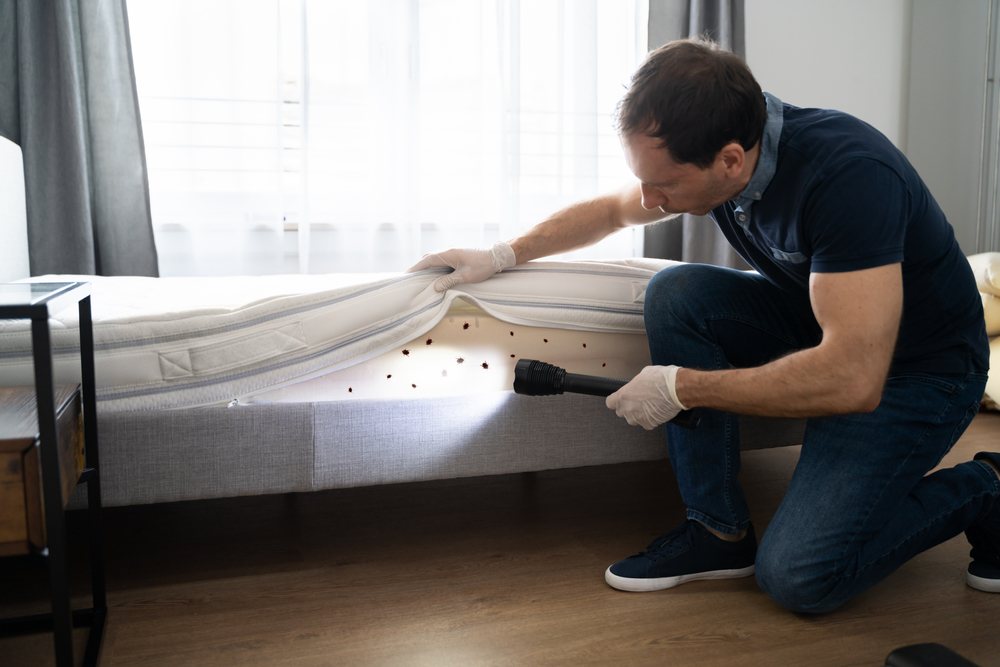




What a long article! Took a while to read and can be hard to digest but good information. I liked the infographic that helped sort of take everything in. Can I send you a picture of the bugs i’m getting in my house? I need help diagnosing and my neighbors don’t seem to help.